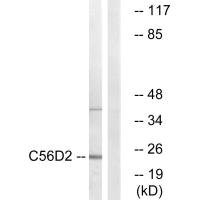CYB561D2 Antibody
-
货号:CSB-PA037456
-
规格:¥2024
-
图片:
-
其他:
产品详情
-
产品名称:Rabbit anti-Homo sapiens (Human) CYB561D2 Polyclonal antibody
-
Uniprot No.:O14569
-
基因名:CYB561D2
-
别名:CYB561D2; 101F6; LUCA12.2; Transmembrane reductase CYB561D2; Cytochrome b561 domain-containing protein 2; Putative tumor suppressor protein 101F6
-
宿主:Rabbit
-
反应种属:Human
-
免疫原:Synthesized peptide derived from internal of Human C56D2.
-
免疫原种属:Homo sapiens (Human)
-
克隆类型:Polyclonal
-
纯化方式:The antibody was affinity-purified from rabbit antiserum by affinity-chromatography using epitope-specific immunogen.
-
浓度:It differs from different batches. Please contact us to confirm it.
-
产品提供形式:Liquid
-
应用范围:ELISA,WB
-
推荐稀释比:
Application Recommended Dilution WB 1:500-1:3000 -
Protocols:
-
储存条件:Upon receipt, store at -20°C or -80°C. Avoid repeated freeze.
-
货期:Basically, we can dispatch the products out in 1-3 working days after receiving your orders. Delivery time maybe differs from different purchasing way or location, please kindly consult your local distributors for specific delivery time.
相关产品
靶点详情
-
功能:Transmembrane reductase that may use ascorbate as an electron donor in the cytoplasm and transfer electrons across endoplasmic reticulum membranes to reduce monodehydro-L-ascorbate radical and iron cations Fe(3+) in the lumen of that compartment.
-
基因功能参考文献:
- The protein exhibits the characteristics typical of members of the cytochrome b561 family, being a hydrophobic, transmembrane heme protein. It is capable of oxidation-reduction reaction and is a candidate tumor suppressor gene product. PMID: 19734123
-
亚细胞定位:Endoplasmic reticulum membrane; Multi-pass membrane protein. Cytoplasmic vesicle membrane; Multi-pass membrane protein.
-
数据库链接:
HGNC: 30253
OMIM: 607068
KEGG: hsa:11068
STRING: 9606.ENSP00000232508
UniGene: Hs.149443
Most popular with customers
-
-
YWHAB Recombinant Monoclonal Antibody
Applications: ELISA, WB, IF, FC
Species Reactivity: Human, Mouse, Rat
-
Phospho-YAP1 (S127) Recombinant Monoclonal Antibody
Applications: ELISA, WB, IHC
Species Reactivity: Human
-
-
-
-
-





















